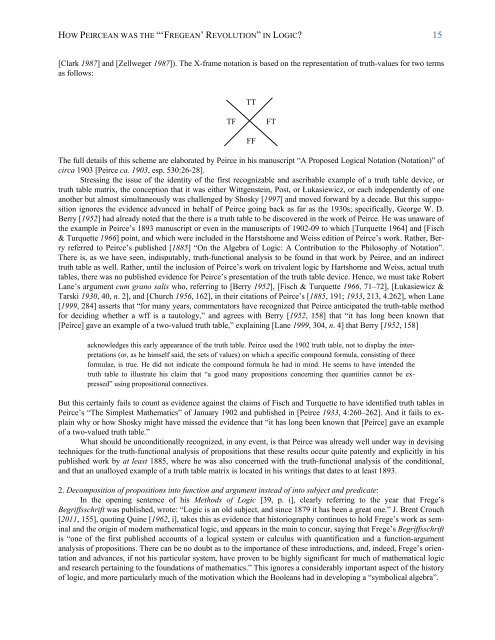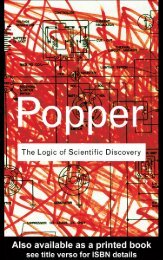Create successful ePaper yourself
Turn your PDF publications into a flip-book with our unique Google optimized e-Paper software.
HOW PEIRCEAN WAS THE “‘FREGEAN’ REVOLUTION” IN LOGIC? 15<br />
[Clark 1987] and [Zellweger 1987]). The X-frame notation is based on the representation of truth-values for two terms<br />
as follows:<br />
TT<br />
TF FT<br />
FF<br />
The full details of this scheme are elaborated by Peirce in his manuscript “A Proposed Logical Notation (Notation)” of<br />
circa 1903 [Peirce ca. 1903, esp. 530:26-28].<br />
Stressing the issue of the identity of the first recognizable and ascribable example of a truth table device, or<br />
truth table matrix, the conception that it was either Wittgenstein, Post, or Łukasiewicz, or each independently of one<br />
another but almost simultaneously was challenged by Shosky [1997] and moved forward by a decade. But this supposition<br />
ignores the evidence advanced in behalf of Peirce going back as far as the 1930s; specifically, George W. D.<br />
Berry [1952] had already noted that the there is a truth table to be discovered in the work of Peirce. He was unaware of<br />
the example in Peirce’s 1893 manuscript or even in the manuscripts of 1902-09 to which [Turquette 1964] and [Fisch<br />
& Turquette 1966] point, and which were included in the Harstshorne and Weiss edition of Peirce’s work. Rather, Berry<br />
referred to Peirce’s published [1885] “On the Algebra of Logic: A Contribution to the Philosophy of Notation”.<br />
There is, as we have seen, indisputably, truth-functional analysis to be found in that work by Peirce, and an indirect<br />
truth table as well. Rather, until the inclusion of Peirce’s work on trivalent logic by Hartshorne and Weiss, actual truth<br />
tables, there was no published evidence for Peirce’s presentation of the truth table device. Hence, we must take Robert<br />
Lane’s argument cum grano salis who, referring to [Berry 1952], [Fisch & Turquette 1966, 71–72], [Łukasiewicz &<br />
Tarski 1930, 40, n. 2], and [Church 1956, 162], in their citations of Peirce’s [1885, 191; 1933, 213, 4.262], when Lane<br />
[1999, 284] asserts that “for many years, commentators have recognized that Peirce anticipated the truth-table method<br />
for deciding whether a wff is a tautology,” and agrees with Berry [1952, 158] that “it has long been known that<br />
[Peirce] gave an example of a two-valued truth table,” explaining [Lane 1999, 304, n. 4] that Berry [1952, 158]<br />
acknowledges this early appearance of the truth table. Peirce used the 1902 truth table, not to display the interpretations<br />
(or, as he himself said, the sets of values) on which a specific compound formula, consisting of three<br />
formulae, is true. He did not indicate the compound formula he had in mind. He seems to have intended the<br />
truth table to illustrate his claim that “a good many propositions concerning thee quantities cannot be expressed”<br />
using propositional connectives.<br />
But this certainly fails to count as evidence against the claims of Fisch and Turquette to have identified truth tables in<br />
Peirce’s “The Simplest Mathematics” of January 1902 and published in [Peirce 1933, 4:260–262]. And it fails to explain<br />
why or how Shosky might have missed the evidence that “it has long been known that [Peirce] gave an example<br />
of a two-valued truth table.”<br />
What should be unconditionally recognized, in any event, is that Peirce was already well under way in devising<br />
techniques for the truth-functional analysis of propositions that these results occur quite patently and explicitly in his<br />
published work by at least 1885, where he was also concerned with the truth-functional analysis of the conditional,<br />
and that an unalloyed example of a truth table matrix is located in his writings that dates to at least 1893.<br />
2. Decomposition of propositions into function and argument instead of into subject and predicate:<br />
In the opening sentence of his Methods of Logic [39, p. i], clearly referring to the year that Frege’s<br />
Begriffsschrift was published, wrote: “Logic is an old subject, and since 1879 it has been a great one.” J. Brent Crouch<br />
[2011, 155], quoting Quine [1962, i], takes this as evidence that historiography continues to hold Frege’s work as seminal<br />
and the origin of modern mathematical logic, and appears in the main to concur, saying that Frege’s Begriffsschrift<br />
is “one of the first published accounts of a logical system or calculus with quantification and a function-argument<br />
analysis of propositions. There can be no doubt as to the importance of these introductions, and, indeed, Frege’s orientation<br />
and advances, if not his particular system, have proven to be highly significant for much of mathematical logic<br />
and research pertaining to the foundations of mathematics.” This ignores a considerably important aspect of the history<br />
of logic, and more particularly much of the motivation which the Booleans had in developing a “symbolical algebra”.





